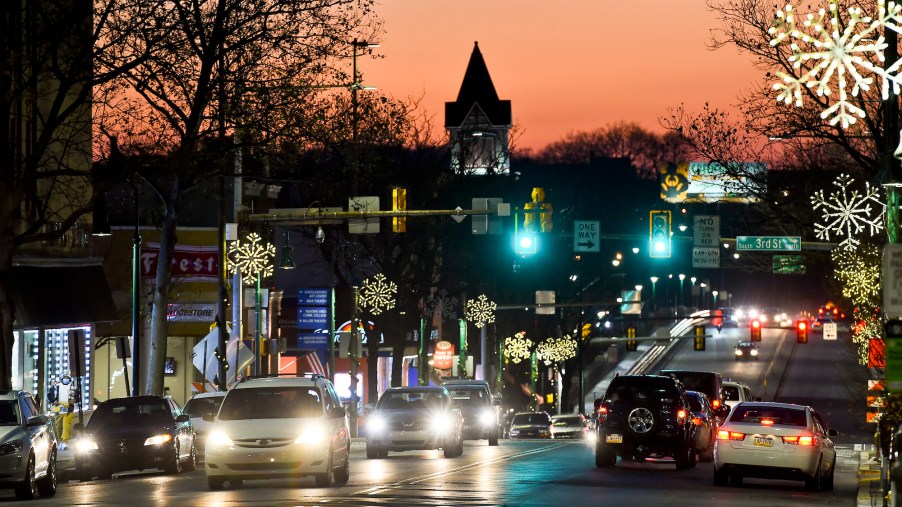
Night Driving 101: How to Avoid Tragedy
Because the winter solstice recently passed on December 21, these are the shortest, darkest days of the year. That, combined with the holidays, means you’re more likely to be out driving in the dark. Because you might be doing more driving than flying this season due to the pandemic, here are a few safety tips for when you’re out on the road at night.
Improve your night vision
The National Safety Council offers several ways to improve how well you see when it’s dark out. Some tips involve car maintenance: aim headlights correctly and ensure they’re clean, dim your dashboard, and clean the windshield to get rid of streaks. Make sure to repair any damage to the headlights or windshield.
Don’t forget to turn on your vehicle’s high-beam lights to improve visibility when there are no oncoming cars. Turn them off when vehicles approach, when you’re driving behind another vehicle, and in poor weather, Self suggests. It’s also helpful to look away from oncoming lights. Drivers who wear glasses should make sure their lenses are anti-reflective.
Be mindful of vision changes
Keep in mind that your night vision fades as you age. Drivers need more light as they age to see as well as younger drivers. Older drivers are also more likely to have cataracts and other eye conditions that limit vision. Glare from oncoming lights can also bother your eyes more with age.
Older drivers, especially, should have annual eye exams. They should also update their prescriptions for eyeglasses and contact lenses as needed. Other ways older drivers can be safer are to take refresher driving courses, minimize distractions, be aware of any medication side effects, and talk with an eye doctor. Some drivers would be wise to limit driving to daylight hours.
Go slower and be a defensive driver
Because it’s harder to see in the dark, drive slower at night. That allows for more time to react to surprises that appear ahead. This also means not following too closely to vehicles ahead of you.
Rush hour, when many people head home between 4 and 7 p.m. on weekdays, can also be dangerous. It’s mostly dark during that time in the winter. To be safer, slow down, stay in your lane, be aware of other drivers, and memorize your route. Also, don’t zone out, and don’t let eating, drinking, or using your phone distract you. While you’re at it, don’t forget to check your car’s blind spots when changing lanes, and remember that it’s harder to see animals, bicyclists, and pedestrians in the dark.
Don’t drive when fatigued
A National Sleep Foundation poll found that 37 percent of people have fallen asleep while driving. Many crashes and near-crashes resulting from driver fatigue happen in the dark (midnight to 2 a.m. and 4 a.m. to 6 a.m.) as well as from 2 to 4 p.m. Drivers should avoid driving after being awake for 16 hours or longer. It’s also best to stop every two hours to take a nap if drowsiness becomes a concern.
Don’t drive impaired
Impaired drivers are most likely to be driving between midnight and 3 a.m. on weekends, so avoid driving during those times whenever possible. Drunk driving has decreased by about a third since 2007, but driving under the influence of drugs has increased. The NHTSA found that 22 percent of drivers in 2013 and 2014 tested positive for drugs that could cause impairment.
Be prepared for emergencies
It’s important to maintain your vehicle, but things can go wrong anyway. The magazine Self suggests keeping a cell phone charger, “first aid kit, flashlight, flares, jumper cables, tire gauge, nonperishable food, extra windshield washer fluid, and blankets” in your vehicle. Also consider bringing extra headlight bulbs, a safety vest, extra facemasks, and sanitizing wipes.
If traveling a long distance, plan driving routes so you know where to find gas stations and rest stops. If your car malfunctions, try to stop in a parking lot or gas station. Otherwise, pull off the road, turn on your car’s hazard lights, carefully exit the vehicle, set up flares, and wear a safety vest to reduce the risk of being hit by another vehicle.
The National Safety Council points out that people do just 25 percent of their driving in the dark but that about 50 percent of traffic fatalities happen at night. Traffic fatalities are also three times greater at night than during the day. It’s important to keep these safety tips in mind to make your drive less dangerous for everyone.


